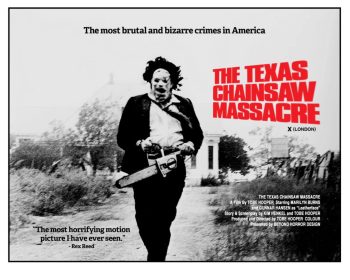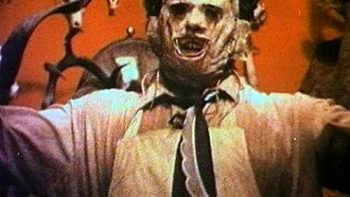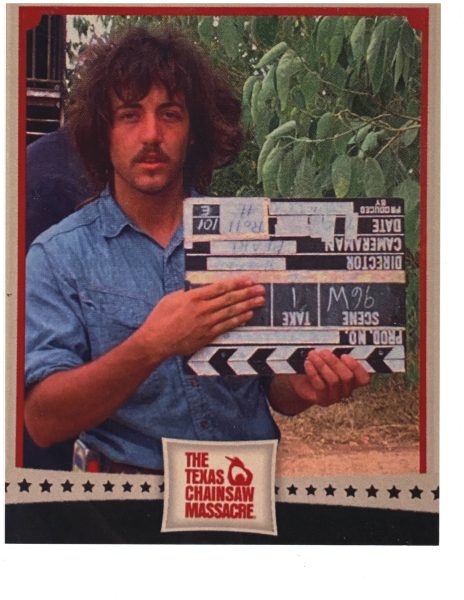THE 50TH ANNIVERSARY OF “THE TEXAS CHAINSAW MASSACRE
AN INTERVIEW WITH CAMERAMAN MICHAEL McCLARY
by
Tom Lavagnino
Has there been a more influential horror film than Tobe Hooper’s original iteration of THE TEXAS CHAINSAW MASSACRE?
The question is worthy of discussion (especially among ScareTube fans), and it’s a subject that takes on special relevance in 2024, as the approaching fiftieth anniversary of the movie’s release (occurring, appropriately enough, on October 1) heralds its watershed commemoration in cinema history. (And a potential boon for retail marketing is in the offing: Can Ace Hardware advertisements, extolling “fifty percent off!” the list price of chainsaws, be on the horizon this Fall?)
Extensive documentation of the Austin-based production of THE TEXAS CHAINSAW MASSACRE, filmed during a legendarily blistering July 1973, is happily available on both YouTube and “addendum menu” Blu-ray content. Deep-dive interviews with co-writer Kim Henkel, cinematographer Daniel Pearl, sound man Ted Nicolaou and actors Alan Danziger, Ed Neal, William Vail, and Teri McMinn are chronicled, among others, as well as several sadly-deceased members of the cast and crew -– art director Robert Burns, actors Marilyn Burns, Gunnar “Leatherface” Hansen, Paul Partain, and Hooper himself.
One of the pivotal surviving members of the original TEXAS CHAINSAW crew, cameraman Michael McClary, ably assisted Daniel Pearl with the look and feel of the film’s visual palette -– a dynamic confluence of composition, color, and shadow that dovetailed brilliantly with the knockout naturalistic acting and incisive Hooper-Henkel script. And while Michael’s career flowered, post-CHAINSAW, with distinguished camerawork on movies such as OTHER PEOPLE’S MONEY, Tobe Hooper’s INVADERS FROM MARS, and ROBOCOP (Michael also directed the feature-film adaptation of Sam Shepard’s CURSE OF THE STARVING CLASS, starring James Woods and Kathy Bates), the TEXAS CHAINSAW experience was instrumental to his film-making career and sensibility.
ScareTube sat down with Michael, in the wake of his February 2024 participation in “CreepFest” (a Texas-based fan convention celebration all things TEXAS CHAINSAW), for a timely discussion of this classic film’s half-century impact.

# # #
SCARETUBE: The influence of TEXAS CHAINSAW cannot be overstated. And it’s true that the movie was a super-inexpensive endeavor, with a budget well under $100,000. How did you become involved with its making?
MICHAEL McCLARY: I grew up in Austin, and went to film school at UT (the University Of Texas at Austin). It was the late 1960’s, the decade of love. There were no diseases so to speak of, no serious crime. It was a beautiful time. Great music was coming through Armadillo World Headquarters. And my Dad, up in Dallas, was going, “I can’t believe you’re down there spending time with those gosh-damn long-haired hippies.” And of course, at the time, I had my hair going all the way down my back like everybody else in Austin, almost to my belt. I loved it so much there, I ended up staying another year (after graduation). It was such a small pond at that time. Everybody knew everybody. So I knew Daniel Pearl, and I heard about the upcoming production of the film. Tobe Hooper had the idea of doing this movie, and it just sounded great to me. It turned out to be the first “professional” film that I ever worked on.
SCARETUBE: Was TEXAS CHAINSAW an outgrowth of the UT film school?
MICHAEL MCCLARY: Not exactly. Daniel and a guy named Ted Nicolaou, who was the sound man on TEXAS CHAINSAW, both worked at the equipment department at UT. And since the school was shut down for the summer, they were able to get in there, and borrow an empty Éclair (camera), and a Nagra (sound recording device), and some lights. Since we had no money to shoot the film in 35mm, Daniel had this clever idea to shoot in 16mm and then blow it up. (On the TEXAS CHAINSAW set) Daniel took a pencil, and scratched the ground glass of the camera eyepiece with it, to form the frame of a 35mm, so that while you were shooting, you could see how it would end up. Because of that, it was very easy to blow it up (to 35mm).
SCARETUBE: What was Tobe Hooper like to work with?
MICHAEL MCCLARY: Tobe was sort of a genius, but he didn’t know it. He was based in Austin, of course, but I don’t think he went to school there. He told me he grew up in St. Louis, in a hotel right out of THE SHINING. He would describe the rooms (that he grew up in) as empty all the time, and as a little kid, they’d just let him go roam all over the place. (On the TEXAS CHAINSAW shoot) he was a fanatic about smoking cigars and drinking Dr. Pepper, and he had a valet named Keith, who was a Marine with long blondish hair, and Keith’s job would be to light (the cigar). So Tobe had his quirks. But he was always saying “what can we do to make this thing better?” And his attitude was, it doesn’t make any difference if it was his idea, or your idea, or somebody else’s idea. “Let’s incorporate it.”
SCARETUBE: The TEXAS CHAINSAW shoot was notoriously low-budget and arduous. Specifically, I’ve heard stories about how intense and crazy it was to shoot that classic “dining room scene” at the end of the movie. What was the vibe on the set overall?
MICHAEL MCCLARY: The heat was overwhelming. The bulk of the movie was shot at night, so everything pretty much required lights. We were just blasting lights all the time. And everything in there (the room where the climactic sequence took place) was so disgusting. But everybody on the cast and crew had a great attitude. You can’t do something like this unless you’re a true believer in the project. So we just went as long as we could, shooting every day. There were some tensions. We had a boom man named Wayne Bell, who was bound and determined to get into every shot. And Tobe developed a dislike of seeing Wayne, even his name. So, we were up in the house one time, looking out the window at the approach of Marilyn Burns (in one shot), it was a wide-angle, fish-eye lens shot, and -– after we got it — Tobe threw down his cigar and said to Daniel Pearl, “I liked that (shot) really well, but Wayne and his god-damned microphone was in the shot again!” And somebody said, “Tobe, he’s not here. We don’t even have a crew call for another hour or so. This is an MOS shot.” But Tobe insisted “it had to be him!” And then it was mentioned, “it’s not Wayne, Tobe. It’s your cigar in the shot.”
SCARETUBE: I guess it was fortunate that all of you were so young at the time, and had such a zeal to make a movie, any movie.
MICHAEL MCCLARY: We didn’t have a professional set decorator, or anybody like that, but there was a young woman on the set who did numerous jobs. So one time she brought around these treats for everyone, one afternoon, and I ate about four of them. And then somebody said, “Michael, those have marijuana in them.” So we’re shooting the scene where Leatherface runs out the door with the chainsaw, and I’m there laughing my head off. I had to go and lie in the back of this van, hoping to come down (from the high). Of course, in Austin at that time, because of its proximity to Mexico, marijuana was everywhere. It was the 1970’s, after all.
SCARETUBE: And yet, despite everybody’s youth and relative inexperience, the camerawork on TEXAS CHAINSAW is incredibly accomplished.

MICHAEL MCCLARY: A lot of the success of TEXAS CHAINSAW can be attributed to the way Daniel Pearl was able to frame (the shots) the way he did. He is just a brilliant d.p. He knew all about the physics about lighting and camera angles. I don’t know how he got so smart about that stuff, but he’s still that way. I don’t think he makes any bad movies, photographically. I stayed with him (on his camera crew) after TEXAS CHAINSAW, and I’ve worked with him many times since.
SCARETUBE: What was your reaction when you saw THE TEXAS CHAINSAW MASSACRE for the first time?
MICHAEL MCCLARY: I was blown away. I don’t remember if I saw it at a cast and crew screening or not, but the movie was amazingly popular from the get-go. I think it was showing at the Paramount Theater, which is a large theater in Austin, and it was really, really well-attended. Everybody just loved it. And while we were shooting it, I never thought for one minute that the film would ever see the light of day, I really didn’t. I’m still amazed. But I think you can never tell with films that you’ve worked on. You go in there with the best intent -– and it’s just like with music, I think -– and you bring everything to it, throw caution to the wind, and maybe something comes of it in the end.
SCARETUBE: What did you do in the immediate aftermath of TEXAS CHAINSAW?
MICHAEL MCCLARY: I was going to go back to school after the movie, but Daniel Pearl, by that time, had bought his own Éclair camera, so we loaded it into his yellow Porsche Targa, and we drove around, all over the South, filming this guy named Larry Raspberry and the High Steppers. It was a music documentary that saw us go to New Orleans and Charleston. After that, I went off and worked on a movie called LEADBELLY, directed by (legendary still photographer) Gordon Parks. And since then, I’ve worked with many, many big-time cinematographers, like Robert Richardson on (Oliver Stone’s) JFK –- our camera department won an Oscar for that -– and Russell Boyd, who was Australian, and I did TENDER MERCIES, ALMOST AN ANGEL, and A SOLDIER’S STORY with him.
SCARETUBE: There are so many instances of low-budget films becoming smash successes — and its makers end up earning peanuts. Did this happen to you?
MICHAEL MCCLARY: No, I’m really lucky. Daniel Pearl was kind enough to give me a “percentage point” in TEXAS CHAINSAW. It turned into what I call “pennies from heaven.” I never really counted on it (while shooting the movie), and Daniel didn’t have to do that, but he did. And it’s been really great for me. I still, to this day, get a profit participation check every quarter from the (original production company) Vortex. Kim Henkel, a very nice guy, set up the company, and runs it, and he spends half of his time in Hawaii, and the other half in Austin. Because if you’re getting the kind of (profit) participation he’s getting, you wouldn’t have to do anything else. It’s really amazing, because I think the budget of TEXAS CHAINSAW, if I’m not mistaken, was $38,000. And then it was sold it to Bryanston, and I think they (Vortex) doubled their money pretty quickly.
SCARETUBE: Daniel Pearl continues to work as one of the top cinematographers in the business. But you had greater aspirations, as both a writer and director, in the wake of TEXAS CHAINSAW’s success.
MICHAEL MCCLARY: Daniel has never wanted to be anything but a cameraman, and it’s really paid off for him. He’s just so amazingly talented. I went on to work on 65 features, and was a cameraman in the camera guild for 18 years, and I just got to the point where I said, “I want to tell the story.” And so Norman Jewison, Oliver Stone, and Bruce Beresford all sponsored me to get into the Directors Guild in 1987. They were such mentors to me. My attitude is, you’re the cameraman, you’ve got to figure (all the visuals) out. You’re the storyteller. I was lucky that I was proficient in camera, and basically grew up around it.
SCARETUBE: THE TEXAS CHAINSAW MASSACRE has become such a touchstone of horror cinema, and now you’re participating, with many of your fellow crew members, on the convention circuit.
MICHAEL MCCLARY: That’s right. It’s been great. Ted Nicolaou, the sound man, has a very wry sense of humor. And there was a long period of time where I didn’t even communicate with him, until I participated in Creepfest. There were 8,000 fans there (in February 2024). People just go nuts for this stuff. Ed Neal was there, too. And Teri McMinn, a great person. All of them are just fantastic, to this day. I’m happy to help (with these conventions) every way I can, to keep the fire of THE TEXAS CHAINSAW MASSACRE alive.
Tom Lavagnino is a playwright, television producer and golfer (18 handicap) living in Southern California. www.tomlavagnino.com







